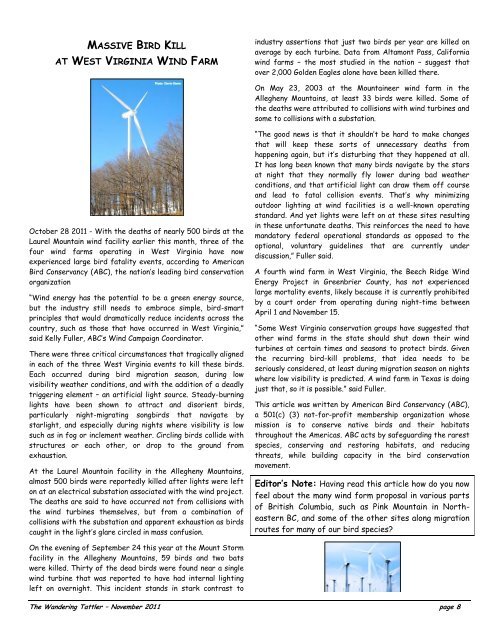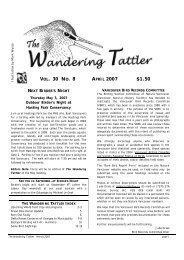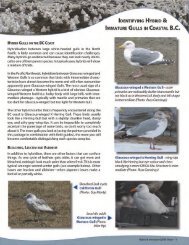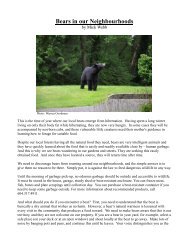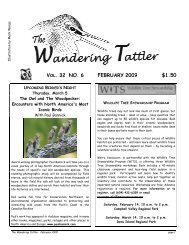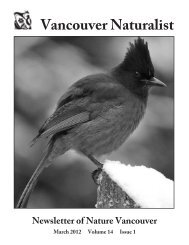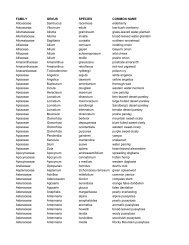Wandering Tattler - November 2011.pdf - Nature Vancouver
Wandering Tattler - November 2011.pdf - Nature Vancouver
Wandering Tattler - November 2011.pdf - Nature Vancouver
You also want an ePaper? Increase the reach of your titles
YUMPU automatically turns print PDFs into web optimized ePapers that Google loves.
MASSIVE BIRD KILLAT WEST VIRGINIA WIND FARMindustry assertions that just two birds per year are killed onaverage by each turbine. Data from Altamont Pass, Californiawind farms – the most studied in the nation – suggest thatover 2,000 Golden Eagles alone have been killed there.On May 23, 2003 at the Mountaineer wind farm in theAllegheny Mountains, at least 33 birds were killed. Some ofthe deaths were attributed to collisions with wind turbines andsome to collisions with a substation.October 28 2011 - With the deaths of nearly 500 birds at theLaurel Mountain wind facility earlier this month, three of thefour wind farms operating in West Virginia have nowexperienced large bird fatality events, according to AmericanBird Conservancy (ABC), the nation’s leading bird conservationorganization“Wind energy has the potential to be a green energy source,but the industry still needs to embrace simple, bird-smartprinciples that would dramatically reduce incidents across thecountry, such as those that have occurred in West Virginia,”said Kelly Fuller, ABC’s Wind Campaign Coordinator.There were three critical circumstances that tragically alignedin each of the three West Virginia events to kill these birds.Each occurred during bird migration season, during lowvisibility weather conditions, and with the addition of a deadlytriggering element – an artificial light source. Steady-burninglights have been shown to attract and disorient birds,particularly night-migrating songbirds that navigate bystarlight, and especially during nights where visibility is lowsuch as in fog or inclement weather. Circling birds collide withstructures or each other, or drop to the ground fromexhaustion.At the Laurel Mountain facility in the Allegheny Mountains,almost 500 birds were reportedly killed after lights were lefton at an electrical substation associated with the wind project.The deaths are said to have occurred not from collisions withthe wind turbines themselves, but from a combination ofcollisions with the substation and apparent exhaustion as birdscaught in the light’s glare circled in mass confusion.“The good news is that it shouldn’t be hard to make changesthat will keep these sorts of unnecessary deaths fromhappening again, but it’s disturbing that they happened at all.It has long been known that many birds navigate by the starsat night that they normally fly lower during bad weatherconditions, and that artificial light can draw them off courseand lead to fatal collision events. That’s why minimizingoutdoor lighting at wind facilities is a well-known operatingstandard. And yet lights were left on at these sites resultingin these unfortunate deaths. This reinforces the need to havemandatory federal operational standards as opposed to theoptional, voluntary guidelines that are currently underdiscussion,” Fuller said.A fourth wind farm in West Virginia, the Beech Ridge WindEnergy Project in Greenbrier County, has not experiencedlarge mortality events, likely because it is currently prohibitedby a court order from operating during night-time betweenApril 1 and <strong>November</strong> 15.“Some West Virginia conservation groups have suggested thatother wind farms in the state should shut down their windturbines at certain times and seasons to protect birds. Giventhe recurring bird-kill problems, that idea needs to beseriously considered, at least during migration season on nightswhere low visibility is predicted. A wind farm in Texas is doingjust that, so it is possible.” said Fuller.This article was written by American Bird Conservancy (ABC),a 501(c) (3) not-for-profit membership organization whosemission is to conserve native birds and their habitatsthroughout the Americas. ABC acts by safeguarding the rarestspecies, conserving and restoring habitats, and reducingthreats, while building capacity in the bird conservationmovement.Editor’s Note: Having read this article how do you nowfeel about the many wind form proposal in various partsof British Columbia, such as Pink Mountain in NortheasternBC, and some of the other sites along migrationroutes for many of our bird species?On the evening of September 24 this year at the Mount Stormfacility in the Allegheny Mountains, 59 birds and two batswere killed. Thirty of the dead birds were found near a singlewind turbine that was reported to have had internal lightingleft on overnight. This incident stands in stark contrast toThe <strong>Wandering</strong> <strong>Tattler</strong> – <strong>November</strong> 2011 page 8


